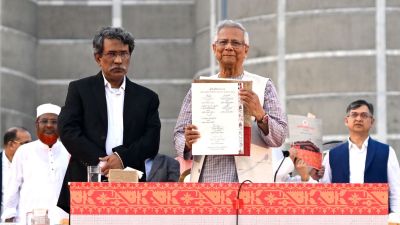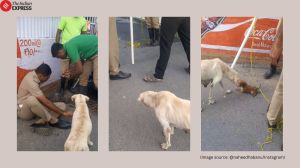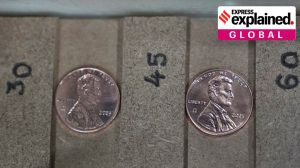Delivering its own Punch
Madame France,Chinese Braggart and an Egypt in crutches recurred more often than Nymph Indiana in a Parsi periodical this must surely excite our Class XI student of political history
Book: Wit and Wisdom: Pickings from the Parsee Punch
Author: Mushirul Hasan
Publisher: Niyogi Books
Pages: 164
Price: Rs 795
Indian cartoon study has a wieldy bibliography,the whole of which can be scribbled into a chit no larger than the pocket cartoon. Even this much is thanks to the scholar who chose to source the odd moment in our cartoons long enough history. How the legendary Subramania Bharati seized the protest art is the subject of A.R. Venkatachalapathys Bharatiyin India Karuthupadangal 1906-1910 (Bharatis India Cartoons). The nationalist poet ran cover cartoons in India,the weekly he edited. He loved the verdant doodle so much that he did everything short of drawing it himself; often posing for his artist to project the anatomical effect he wanted in the cartoon. Closer to our times,Sundar Ramanathaiyer and Nancy Hudson-Rodd tracked a more mature phase of the editorial cartoon in Tragic Idiom: O.V. Vijayans Cartoons & Notes on India. Add to these Ritu G. Khanduris work on Indian comic art and Subhendu Dasguptas pursuit of Bengali cartoons from 1872 to the present and we are ready to welcome Mushirul Hasan.
These happy highlights have a beginning that goes back to the crossover of the colonial cartoon across the country as Punch clones. By one account,by the end of the 19th century,there were as many as 70 publications in over a dozen Indian towns that carried the P-word in the title. Parsee Punch,hopefully only the second of a series,comes after Mushirul Hasans own pioneering commentary,Avadh Punch: Wit and Humour in Colonial North India. When the Urdu weekly was launched from Lucknow in 1877,the Avadh province in the aftermath of the 1857 Revolt was ripe for political debate. More,the alien subversive genre found a natural habitat in a language that was buzzing with much satire,word play and parody.
The cartoon does not flourish in isolation. Itself a text and image hybrid,this eclectic popular art,drawing freely from graffiti to graphics and poetry to politics,has historically grown in the company of literary forms. The Tatler and The Spectator hosted the English novel,and The New Yorker the American short story,which incidentally it has begun to tweet. Hasan says Avadh Punch laid the foundations of Urdu short stories and literary journalism,and rendered the same service to the Urdu novel. Six years back,when this unique cartoon study by a professional historian came out,the effort was no less noticed for the larger point made that the 19th century northern Indian Muslim didnt live in denial but engaged with much of what was going on in those uneasy times. The author had pricked the ballooning stereotype ever so gently as the best of cartoons do.
When in those days of the Raj,native communities felt stirred enough to launch a humour magazine,the London Punch (1841-2002) was the ready model. Even for the Parsis,caught less in the subcontinents power matrix than Muslims,there was no dearth of stirring issues interestingly more global than local. Colonial fortunes were being made or marred in broad continental sweeps that concerned societies a lot more then than they do in this self-proclaimed glocalised era. Must be no news to the pundit,but the fact that John Bull,Madame France,Chinese Braggart,Russian Puppeteer and an Egypt in crutches recurred more often than Nymph Indiana in archival cartoons in a Parsi periodical must surely excite our Class XI student of political history.
Between their strongholds,the 16th century Surat and the 19th century Bombay,Parsis grew every which way,except numerically. Like all prospering identity-bound groups,enough to attract put-downs. They remained for a while the butt of jokes: If a Parsi grows rich,he takes a second wife. Didnt take long for such jibes to give way to grudging admiration: One Parsi stroke,a cannon ball. An obvious reference to how well the newcomer took to cricket. When Lady Meherbai Tata played professional tennis in a sari,her kinsmen were ready with a journal to allude to it in a cartoon that showed a fashionable Parsi woman in oriental wear doing weights. Parsee Punch had already been in place from July 1854 as a bilingual weekly in English and Gujarati with a monthly supplement of pickings from it.
This selection from the first six months of the journal leaves you with the feeling that the cartoon periodical was one more way the Parsis told the world they had arrived. The bunch of vintage cartoons may not measure up to the much-vaunted confidence to take a joke,but surely betrays the inevitable levity that comes with a settled lifestyle. As with his prequel,Mushirul Hasan doesnt analyse and paralyse the cartoon here either. His is a non-invasive text that runs freely,parallel to the generously displayed line art. His words can hardly be bettered: Every generation has its own standard of critical judgement,but there is no denying these cartoons introduce a certain tenderness and loftiness of feeling.



- 01
- 02
- 03
- 04
- 05




























